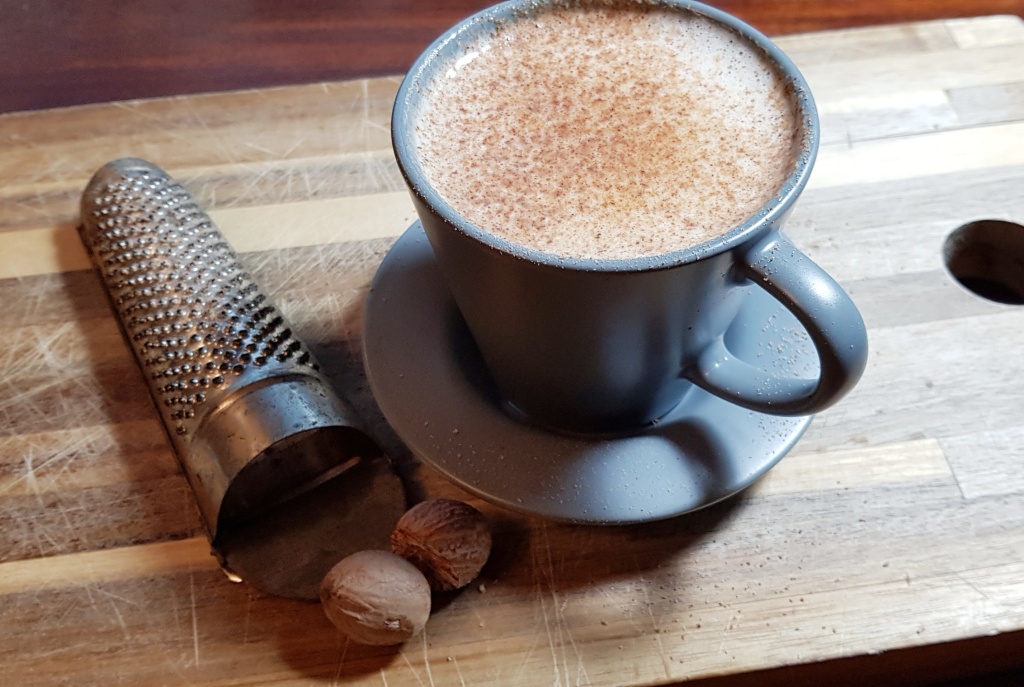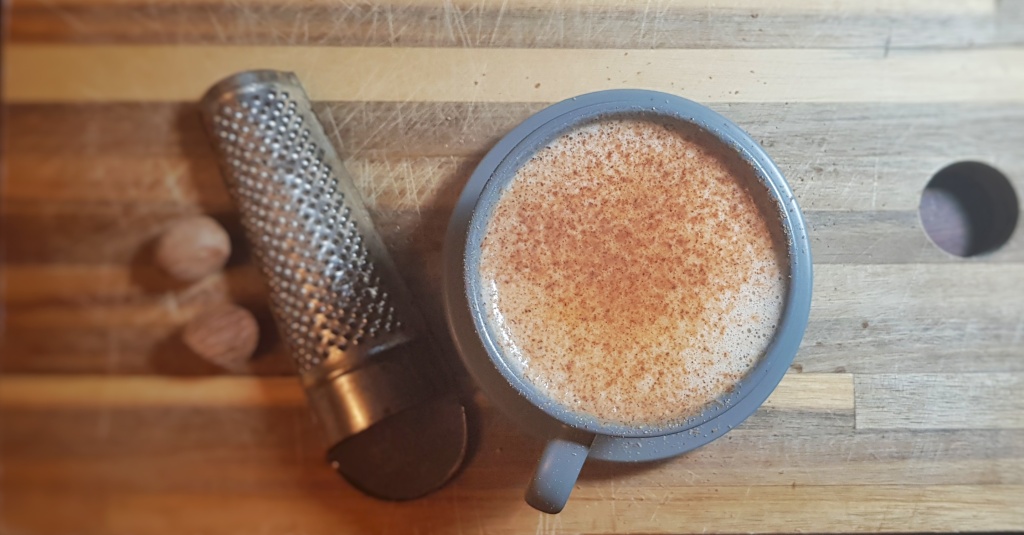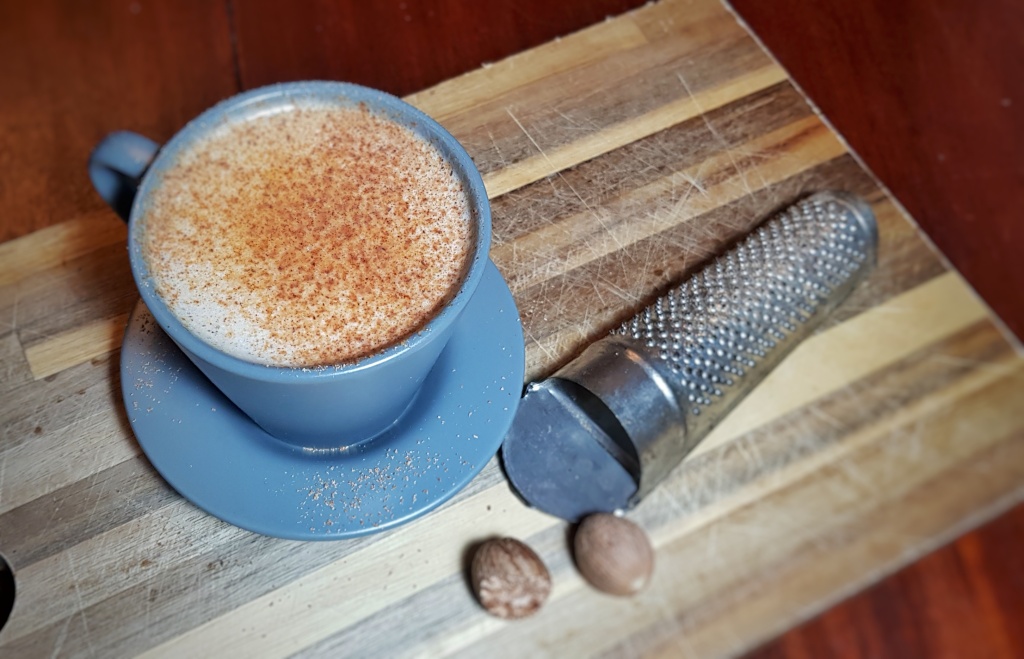Merry Christmas everyone! It’s been yet another long and arduous year, but now it is time to kick back your heels – even if it is only for a short time – and to aid you in this I present my annual Christmas boozy drink post. This year, it one of my favourites: eggnog (regular readers will know of my love of anything custardy).
Eggnog isn’t really drunk that much in Britain, but it is very popular in the United States. Indeed, it is where I discovered it; I remember walking through the campus of Washington University in St. Louis, Missouri, in the winter term seeing several students chugging big cartons of the stuff on their way to lectures (it’s worth pointing out that the bought stuff in cartons contains no alcohol; you add your own later, should you wish to).
For those not in the know, eggnog is a thick, creamy drink made from a dark spirit, usually rum (though brandy, whisk(e)y or sherry can be used), cream or milk, eggs, sugar and spices. The ingredients are either whisked up and served chilled and frothy, or cooked like a custard and drunk hot or cold. Here’s a description of the process from nineteenth century American historian and politician Nathaniel Bouton, writing about the US in the late eighteenth and early nineteenth centuries:
Another favourite drink was egg-nog, which was composed of an egg beaten and stirred together with sugar, milk and spirit…The stick used for this purpose was split at the end and a transverse piece of wood inserted, which was rapidly whirled around, back and forward, between the palms of the hands. Skilful men made graceful flourishes with…“egg-nog” sticks in those days.[1]
The drink was invented in the late colonial era, and was enjoyed all year round; it became associated with Christmas because two of the primary ingredients – eggs and cream – were expensive in wintertime and so could only be enjoyed as a treat. Therefore, it was saved for Christmastide (unless you were rich, then it didn’t matter). A tradition, one I whole-heartedly agree with, was quickly established to breakfast upon eggnog on Christmas morning. This was extended, for those who could afford it, to the full twelve days of Christmas.[2] So ubiquitous was it that eggnog was ‘consumed heartily by slave owners, slaves and children alike.’[3]
There was a drop in popularity during Prohibition,[4] but it has certainly since recovered because according to Indiana University ‘[i]n 2007, eggnog consumption nationwide was 122 million pounds with peak sales occurring the week before Thanksgiving, the weeks of Christmas, and just after Christmas.’[5]
If you like the blogs and podcast I produce and would to start a £3 monthly subscription, or would like to treat me to virtual coffee or pint: follow this link for more information. Thank you.
You may be wondering: “Er, why are you telling me about an American drink on a blog about British food history?”
Good question.
Well first you could argue that colonial America was a part of Britain, being part of its proto-empire; and second, eggnog is part of the evolution of a British drink called posset, something I have already written about. Possets were made[6] by beating or whisking alcohol – usually sweet wines and sack – with hot milk or cream, sugar and spices. Sound familiar? There was a problem for anyone making a posset in North America because sweet, imported wines were very expensive, prohibitively so for many, and so a cheap alternative was required. In eighteenth century America this was rum, and so the posset was adapted and became eggnog.
You can make your eggnog hot or cold. The hot version is a wonderful, luscious silky-thick custard, and with freshly grated nutmeg it’s just like a boozy, liquid custard tart. This you can enjoy cold too. The uncooked cold one is very different, the eggs, milk and cream froth up after a good shaking, to produce a surprisingly light and refreshing drink.
My recipe makes enough for two people so that if you are going for the uncooked version you can fit the ingredients in a cocktail shaker. If you want to make more, you’ll have to froth the mixture in a bowl with your best eggnog stick, or failing that, a whisk.
If you want to make a cold eggnog, use sugar syrup,[7] if hot can use sugar syrup or caster sugar. Note that the cold one uses raw eggs, so buy good quality free-range eggs, and avoid giving the drink to anyone immunosuppressed.
Serves 2
4 shots (100 ml) dark rum (or brandy, whisk(e)y, sherry etc.)
50 ml sugar syrup or 25-30 g caster sugar
2 eggs
150 ml whole milk
150 ml double cream
Freshly grated nutmeg
Ice cubes (if drinking cold)
To make cold: In a cocktail shaker filled with cubed ice, add the alcohol, sugar syrup, eggs, milk and cream. Shake very well indeed and strain the eggnog through a fine sieve into two glasses filled with more ice cubes. Grate some nutmeg over the top and serve.
To make hot: place the alcohol, three-quarters of the sugar or sugar syrup, eggs, milk and cream in a saucepan and place over a medium-low heat and beat with a small whisk. When fully mixed, keep stirring until the mixture begins to thicken. Remove from the heat but continue to stir. Taste, and add more sugar if desired.
Pass through a fine sieve into two glasses, grate nutmeg over the top and serve.
Notes:
[1] Bouton, N. The History of Concord From Its First Grant in 1725, to the Organization of the City Government in 1853. (Benning W. Sanborn, 1856).
[2] Wondrich, D. The Oxford Companion to Spirits and Cocktails. (Oxford University Press, 2021).
[3] Shanahan, M. Christmas Food and Feasting: A History. (Rowman & Littlefield Publishers, 2019).
[4] Wondrich, D. (2021).
[5] Christmas by the Numbers. Indiana University https://www.ibrc.indiana.edu/studies/factoid/dec09.pdf.
[6] I say were made. Modern day possets are not really a drink, more a set dessert. Very delicious, but really quite different to those of the eighteenth century.
[7] To make a sugar syrup mix equal weights of white or golden caster sugar and hot water. Stir to dissolve and leave to cool. Easy.











